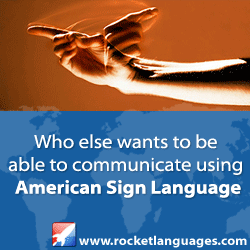Sign Language Courses
0Learning American Sign Language is a wonderful way to communicate with friends, family, and strangers who are audibly impaired.
American Sign Language is a non-spoken language. Of the non-spoken sign languages, ASL is one of the most popular amongst the audibly impaired globally.
That term, audibly impaired, applies both to those individuals who are deaf and those who are otherwise hard of hearing.
It is a second language, but many people actually don’t think of American Sign Language (also known as ASL) when they are thinking of learning a second language. Most people, at least in the United States, would think to take something like Spanish, German, or French over ASL.
So you’ve made it to this point, past the Spanish, German, and French to American Sign Language as a second language you are interested in learning. What now?
A new language is right there at your fingertips (and hands, arms, and body language).
Handfuls of new expressions are close at hand.
There is no way you will walk away empty handed.
If you can get your hands on some great resources, learning to sign can be easier than you think.
And if you are someone who dislikes having their fingers walk the pages of a textbook, there are still plenty of options out there for you. Not all of the courses teaching you how to sign in American Sign Language involve a lot of textbook reading.
What are your options as far as ASL courses?
Physical Classrooms
Physical classrooms where you can learn American Sign Language are very interactive. The fact that this is a non-verbal language means the teacher can understand all the students when they respond at once.
Many ASL courses, especially for younger students, alternate days of teaching new words through repetition, and using them. This can include ask and response type of courses where the teacher verbally asks or signs a question then the students sign their answers back.
Except when it is a one-on-one course or sometimes during testing, learning is a group activity. Students are often encouraged to look to their neighboring students if they are unsure of the correct sign in response to a question.
However, there are downsides to taking an ASL course in a physical classroom. Mainly, you physically have to be there. That just isn’t a viable option for everybody.
Online Classrooms
Taking a course in American Sign Language online can be idea if you can’t commit to attending a scheduled class. This option offers a lot more flexibility.
You are also able to learn more at your own pace. Say you are struggling to memorize the finger signing alphabet (used often to spell out proper names or words without a common sign). In a physical classroom, you might then fall behind. With an online course, you can repeat the lesson until you fully understand.
An example of courses available online to learn American Sign Language can be found at RocketLanguages.com. Affordable lessons, as well as a free trial, are available.
However, online learning has its disadvantages, too.
Disadvantages, in fact, that come as a tradeoff for its flexibility: you aren’t physically surrounded by other students or the teacher. Because of this, some people do experience a disconnect with the content while trying to learn in an online setting.
You just have to weigh the costs and benefits to see if this option would be a better fit for you.
Course Topics
American Sign Language is a rich language full or words, sayings, grammar, and culture. In order to properly learn the language, you must come to understand all of its elements and nuances.
Just because this isn’t a verbal language, that doesn’t mean learning it will be effortless or a walk in the park. Repetition for memorization will still be one of your best friends. It will still take time to learn this language, just like with any language.
While technically not ASL, finger signing does go hand-in-hand with American Sign Language. Finger spelling helps to fill in the blanks, the words that don’t have equivalents in ASL.
Conclusion
If you are hoping to learn American Sign Language, you have the option to take a course centered around the language. Some courses are offered in physical classes while others are offered online through providers such as Rocket Languages.
If you are struggling to grasp a concept, it may be beneficial to sit down one-on-one with an individual who is fluent in ASL. They may be able to help you overcome your hurdles.




